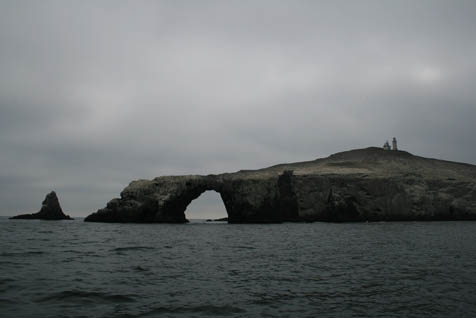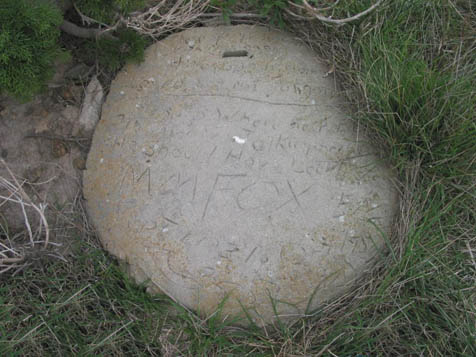A Journey to Anacapa Island’s Dark Side
The Deceptive Isle

The park ranger’s directions were solid. Take the trail to the building that looks like a church but isn’t a church. Climb the hillside in back; keep walking until you are even with the middle window on the second floor of the structure. There, hidden in the grass, I’d find one of Anacapa Island’s best-kept secrets, he told me.
A two-hour sail from the mainland, typical activities while visiting Anacapa Island involve kayaks, seals, and starfish. But I’m not the type who likes my outdoor adventures to be nothing but sunshine and wildflowers. I’m a former park ranger with a fetish for hauntings and mysterious stories set in national parks.
The name Anacapa is a corruption of a Chumash word for “deception” or “mirage” or “ever-changing.” It’s a poetic name for an island that shifts its shape-becoming one isle or three and appearing long and thin or large and massive, depending on the direction of approach. It’s a fitting name for an island so rocky and fog enshrouded that at least a dozen ships have smashed into its shores. It’s a splendid name for an island that likes to keep its skeletons in the closet. One of them quite literally.
The official government response to my inquiry about hauntings is “there are no ghosts on Anacapa.” But Ranger Dave Chapman disagreed. “Sure it’s haunted,” he told me over the phone from his new post at Arizona’s Grand Canyon. Chapman worked at Channel Islands National Park from 1998 to 2000. For two of those years, he lived in the lighthouse keeper’s quarters, now used as a ranger residence. And Chapman said he’s not the only park employee who has heard someone or something pacing in the attic. Nor is he the only one who has seen a normally sticky door slam unaccountably. And you can’t talk about Anacapa for long without him mentioning the birds.

“You know that Hitchcock movie [The Birds]?” Chapman said. “Well, I lived a real-life version of it.” Thousands of Western Gulls descend upon Anacapa each summer to mate and lay their eggs. The gulls are extremely protective of their offspring. One day, Chapman said, “I was attacked so viciously, blood ran down my face.”
Chapman’s worst tour, however, occurred when a bout of nasty weather forced him to remain alone on Anacapa for 22 days. Twenty-two days of pea-soup fog. Twenty-two days of blaring foghorn. Twenty-two days of shrieking sea gulls. Twenty-two days without seeing a single soul, at least not one who is among the living. “Mind games definitely go on in a situation like that,” Chapman said. “You think you hear things. You see things that aren’t there. Your mind starts to play [tricks].” (Despite the island’s horror movie atmosphere, park rangers are pros at enduring solitude in the wilderness and appear to be immune to island fever. Chapman described his two years on Anacapa as a “dream job,” although he admitted the combination of fog, wind, and isolation certainly could unhinge an unstable psyche.)
Before the lighthouse was automated in 1968, members of the U.S. Coast Guard lived on the island to work the lifesaving light. It must have been a boring assignment for a young man; we shouldn’t blame these boys if they entertained themselves in bizarre ways. For example, in 1985, Ranger Mary Valentine related to a reporter for the Ventura County Star-Free Press an “often told story” about a human skeleton that the seamen kept in the closet of their quarters. According to Valentine, the men dubbed the skeleton “Joe” and would rattle the bones at “a few hardy souls who visited.” As to the current whereabouts of this skeleton or the real name of its original owner, Ranger Valentine didn’t have a clue.
Even Raymond “Frenchy” LaDreau, a man who loved Anacapa so much he lived a hermit’s existence there for 28 years, had to escape the foggy cliffs from time to time. In 1931, Frenchy allowed a friend to cabin-sit for him while he traveled to the mainland for a dose of civilization. A month later, Frenchy returned to find his friend, a Swede named Iver Steen, dead from a gash in his neck.
Steen’s bloody demise remains one of Anacapa’s many mysteries. References to the death are vague and conflicting. One reporter claimed Frenchy told him that his friend had been murdered in his cabin. Others wrote that the death was a suicide induced by a painful attack of delirium tremens-the theory being that the alcoholic “cured” his addiction by slitting his own throat with a fishing knife.
Four hours at the Ventura County Museum Library failed to provide me with any more details about Steen or the other men who died on Anacapa Island. But rangers had mentioned a memorial behind the water tank building dedicated to a Coast Guard seaman. They said the man was pushing a load of refuse into Garbage Cove with a tractor. The other workers yelled a warning, but the tractor driver wasn’t paying attention. In horror, the men watched their distracted coworker drive the tractor off the cliff.
With so many spirits harboring motives to haunt, it’s hard to know who’s been slamming doors and pacing the attic above the ranger station. Nonetheless, I went to the deceptive island to investigate. The “memorial” behind Anacapa’s water tank building is nothing more than a round slab of concrete with an inscription faded by 50 years of wind and rain. A seagull eyes me suspiciously as I finger the letters, hoping to know their meaning by touch. Standing over the disintegrating memorial, struggling to read its message, I skip over the more challenging lines until I make out the words “Here is where he fell.” The deceased’s name appears to be M.M. Fox, born September 1, 1921 and died on an unreadable date in 1954. According to the inscription, M.M. Fox was “loved and not forgotten.”
There’s no reference to a wife or family, but someone cared enough to add a drawing of a sailboat gliding across ocean waves. Yet, in addition to this kindness, there is a sentence that slaps me with its callousness: “This man was talking when he should have been listening.” I put myself in the shoes of the men who were there, who crawled to the edge of a cliff to see a friend’s lifeless body mangled on the wet rocks 100 feet below. Then I understand the frustration that would compel a person to put a stick into a slab of wet concrete and write such a line.
I rush back to the boat before a storm front shrouds the island with mist. We sail home under violet skies toward the mainland, where houses along the shore still reflect the sun’s warm glow. Within minutes, Anacapa Island has vanished. I gaze back across the churning waters and see nothing but fog.



